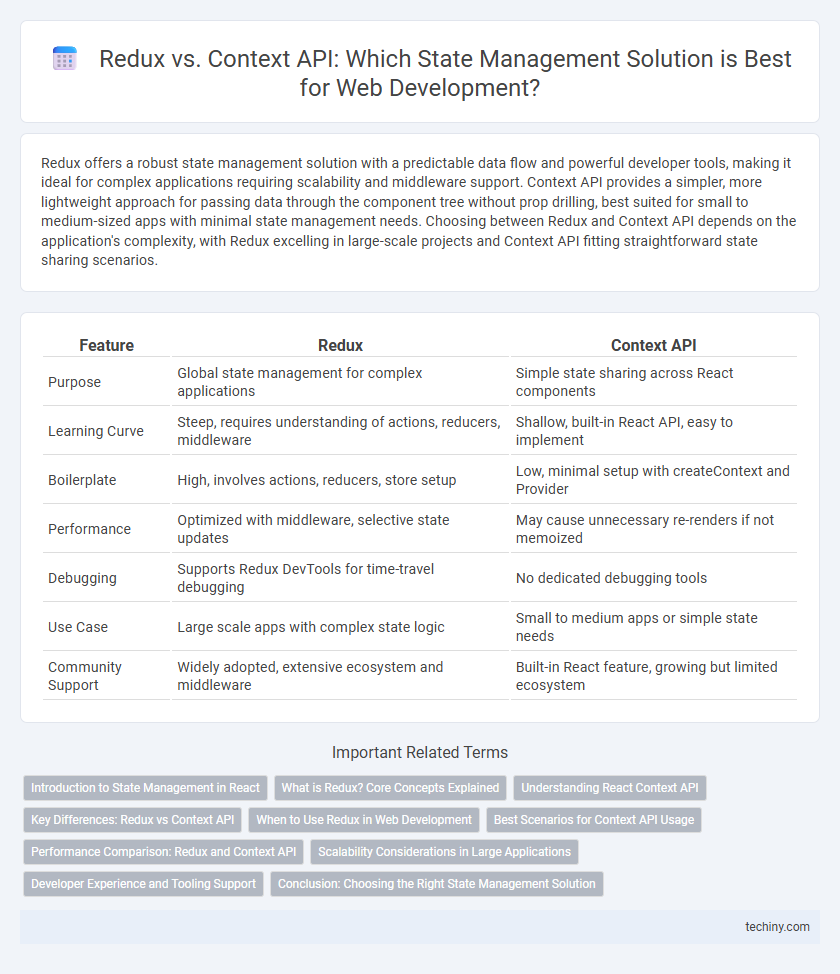Redux offers a robust state management solution with a predictable data flow and powerful developer tools, making it ideal for complex applications requiring scalability and middleware support. Context API provides a simpler, more lightweight approach for passing data through the component tree without prop drilling, best suited for small to medium-sized apps with minimal state management needs. Choosing between Redux and Context API depends on the application's complexity, with Redux excelling in large-scale projects and Context API fitting straightforward state sharing scenarios.
Table of Comparison
| Feature | Redux | Context API |
|---|---|---|
| Purpose | Global state management for complex applications | Simple state sharing across React components |
| Learning Curve | Steep, requires understanding of actions, reducers, middleware | Shallow, built-in React API, easy to implement |
| Boilerplate | High, involves actions, reducers, store setup | Low, minimal setup with createContext and Provider |
| Performance | Optimized with middleware, selective state updates | May cause unnecessary re-renders if not memoized |
| Debugging | Supports Redux DevTools for time-travel debugging | No dedicated debugging tools |
| Use Case | Large scale apps with complex state logic | Small to medium apps or simple state needs |
| Community Support | Widely adopted, extensive ecosystem and middleware | Built-in React feature, growing but limited ecosystem |
Introduction to State Management in React
React state management handles dynamic data rendering efficiently by tracking component states and ensuring UI consistency. Redux centralizes application state in a single store using actions and reducers, offering predictable state updates ideal for large-scale applications. Context API provides a simpler, built-in solution for sharing state across components without prop drilling, best suited for moderate state management needs.
What is Redux? Core Concepts Explained
Redux is a predictable state container for JavaScript apps, widely used in web development to manage application state consistently across components. It revolves around core concepts such as a single immutable state tree, actions as plain JavaScript objects describing state changes, and reducers as pure functions that handle those actions to update the state. This centralized state management facilitates debugging, state persistence, and scalability in complex React applications.
Understanding React Context API
React Context API provides a streamlined way to share state across a component tree without prop drilling, making it ideal for managing global data such as user authentication or UI themes. Unlike Redux, Context API is built into React, offering a simpler setup with less boilerplate, though it may lack some advanced features like middleware and time-travel debugging. Developers often choose Context API for smaller applications or specific use cases where state management complexity is minimal.
Key Differences: Redux vs Context API
Redux offers a robust state management solution with a predictable state container, middleware support, and advanced debugging tools, ideal for complex applications requiring scalable and centralized state handling. Context API provides a simpler way to pass data through the component tree without prop drilling but lacks the middleware and performance optimizations of Redux, making it better suited for smaller applications or localized state management. Redux's strict immutability and action-based state transitions contrast with Context API's more flexible but less structured approach, impacting maintainability and debugging capabilities.
When to Use Redux in Web Development
Redux is ideal for managing complex state logic in large-scale web applications where predictable state updates and centralized state management are critical. It excels in scenarios requiring advanced debugging capabilities, time-travel debugging, and middleware integration to handle asynchronous actions. Developers should choose Redux when the application demands a robust state architecture supporting scalability and maintainability beyond the simpler Context API.
Best Scenarios for Context API Usage
Context API excels in managing state in small to medium-sized React applications where the state logic remains simple and doesn't require advanced middleware functionalities. It is best suited for passing data like user authentication status, theme settings, or language preferences across deeply nested components without prop drilling. When applications demand minimal global state management with fewer re-renders and straightforward updates, Context API provides a lightweight and efficient solution compared to Redux.
Performance Comparison: Redux and Context API
Redux offers superior performance for managing large-scale state due to its optimized state updates and middleware support, reducing unnecessary re-renders. Context API, while simpler to implement, can lead to performance bottlenecks in complex applications because it triggers re-renders for all consuming components on state changes. Developers should consider Redux for high-performance requirements and Context API for lightweight, smaller-scale state management.
Scalability Considerations in Large Applications
Redux offers superior scalability for large applications due to its centralized state management and middleware support, enabling efficient handling of complex state logic and asynchronous operations. Context API is best suited for simpler state needs but can lead to performance bottlenecks and prop drilling issues as the application grows. Developers often prefer Redux in enterprise-level projects to maintain organized, maintainable, and scalable codebases over time.
Developer Experience and Tooling Support
Redux offers robust developer experience with a rich ecosystem of middleware, devtools like Redux DevTools for time-travel debugging, and strong TypeScript support, enhancing state management in complex applications. Context API provides a simpler, more intuitive API with less boilerplate, ideal for small to medium projects but lacks advanced debugging tools and middleware integration. Developers choosing between Redux and Context API often prioritize Redux for large-scale apps requiring extensive tooling and Context API for straightforward state sharing with minimal setup.
Conclusion: Choosing the Right State Management Solution
Redux offers a robust, scalable state management solution ideal for large-scale applications with complex state logic and predictable state updates. Context API provides a simpler, built-in alternative suited for smaller projects or localized state sharing without the overhead of external libraries. Selecting between Redux and Context API depends on application complexity, team familiarity, and performance requirements, ensuring efficient state management tailored to project needs.
Redux vs Context API Infographic

 techiny.com
techiny.com